Film-forming materials - varnish, paint, primer, sealer, insulator, varnish - can be applied by various methods. The most common industrial method is spraying. But it can also be used for DIY projects. Those who are just starting to refinish a piece of furniture in their home or occasionally refinishing a small wooden object will most likely turn to the brush. But there are also hobbyists who have taken it to the next level and find that a small compressor and spray gun is not a big investment. It's a good investment because spray application results in a more even, well spread film and application time is much shorter.
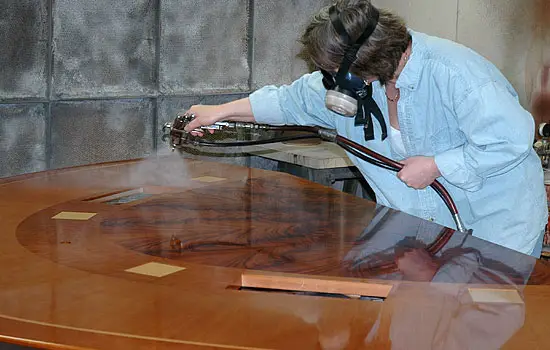
Spray application in factories
In industry, spray application is preferred because it adapts to the shape of any object. Most finishing products can also be applied by spraying. In contrast to DIY, industry uses more powerful guns that are much more durable and durable. Simple spray guns or pumps can be used.
The spraying method is more diversified, more adapted to the purpose and final result. The materials are applied by conventional spraying, low or high pressure, air mix, air less, electrostatic, automatic. I will detail these methods on another occasion. Right now I have set out to make some general recommendations for spraying under normal conditions, i.e. when it comes to compressor, gun and conventional spraying. They may seem trivialities to the connoisseur, but I think it does no harm to be reminded of them from time to time.
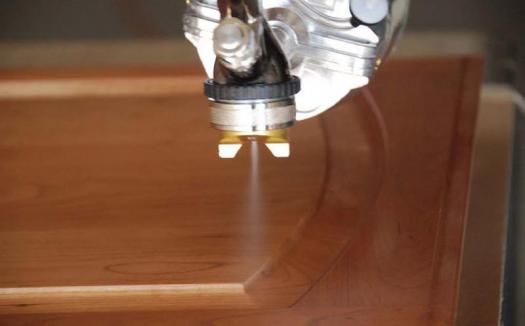
photo source: canadianwoodworking.com
Spray gun nozzle recommendations
The nozzle is the orifice through which the material exits the gun under pressure. It is of different sizes and must be adapted to the material to be applied. For products with high fluidity and which must be applied in small quantities, such as ageing patinas, nozzles of 0,8-1,0 mm are recommended.
For fluid products that are applied in larger quantities (baths), the recommended nozzle is 1.2-1.4 mm. For varnishes, primers, sealers to be applied under normal conditions, without special requirements, a nozzle thickness of 1,8-2,0 mm is recommended. When applying viscous, thixotropic products (such as exterior water-thinnable varnishes), the recommended nozzle is 2,5-3,0 mm.
Conventional spray application pressure
The recommended pressure for normal (conventional) application is 2.5-3.5 atm. But the general tendency is to work at much higher pressure, 5 atm or even more. The explanation of those who do this is that it gives better productivity. This is the wrong approach.
Indeed, the fact that the lacquer comes out of the gun more and faster makes us work faster. But the loss of material will be much greater and the quality of the film poorer. The amount of lost varnish that does not settle on the object to form the film is called over spray, will be much higher.
The high pressure will also prevent the material from settling evenly and forming a good-looking film. Also because of the high pressure, some of the sprayed varnish will dry in the air, settling on the surface as dust. The still-wet varnish will trap the dust and fix it, resulting in a rough and glossy film. In factories they say the film is gassed.
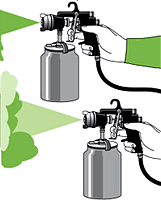
photo source: achitettodileo.it
Adjusting the lacquer spray, the distance between the workpiece and the nozzle, the movement of the gun in relation to the plate
Before starting spraying, the spray pattern must be adjusted. For a quality application, the spray pattern should be neither very tight, like a thread, nor very open, like a shower. Optimum application is obtained with a horizontally tight and vertically open spray.
The spraying distance should be 15-20 cm. Less than this distance will result in a streaky film, and when the distance is greater the film does not settle evenly and gassing may occur. To avoid gassing when finishing fitted furniture the back must be removed. Thus over spray does not remain inside the furniture body.
The movement of the hand over the finishing panel is translation, not rotation, and the hand always remains at the same distance from the panel.
The hand holding the pistol should be in line with the arm, forming a continuous straight line. If your hand is held up or down at an angle to your arm, you will tire more quickly because your nerves and blood vessels are strangledand the quality of the film will suffer.
For a correct and even application over the entire surface, the spray must go beyond the edges of the workpiece, and stripes of applied material to overlap 30%. A trick to avoid gassing is to apply the varnish starting from the side next to you and working toward the far side. This will cover any varnish dust that has fallen on the piece with fresh material. When there is good exhaustion we can spray in the usual way, from the far side towards the near side.
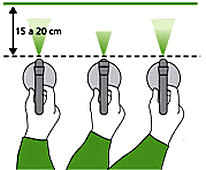
photo source: achitettodileo.it
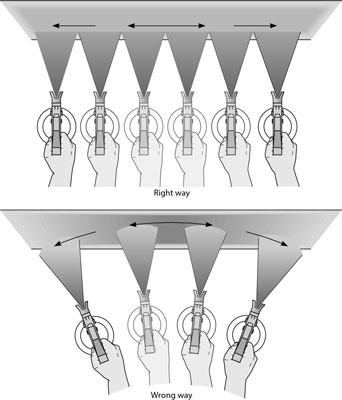
photo source: dummies.com
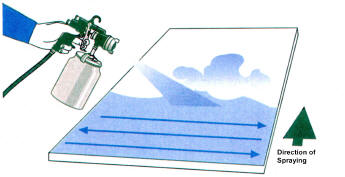
photo source: ognigiorno.it
Requirements for spray guns
Spray application of waterborne products is done with stainless steel spray guns. Stainless steel spray guns can also be used for the application of solvent-based products. So to avoid problems with rust, it is best to buy a stainless steel gun.
If viscous products need to be applied and the compressor does not provide the necessary pressure to get the material out of the gun, you can use special guns for such products. They create pressure inside the nozzle of the gun forcing the material out. If you frequently apply viscous products, but don't have the money to buy a pump, such a gun is very helpful.
After the application of chemically hardened A+B type materials (polyurethane, acrylic, polyester, etc.), the gun and the circuits must be thoroughly washed. If left with the material in them, the lacquer hardens inside and the gun cannot be used. Washing is done with lacquer solvent (organic solvent or water), spraying the solvent until it comes out of the gun clean.
At the end of the working day the gun is taken apart and washed thoroughly, leaving the parts in the thinner. This prolongs the life of the nozzle and therefore of the gun. If not well maintained, the nozzle will change diameter over time with repercussions on the quality of the film.
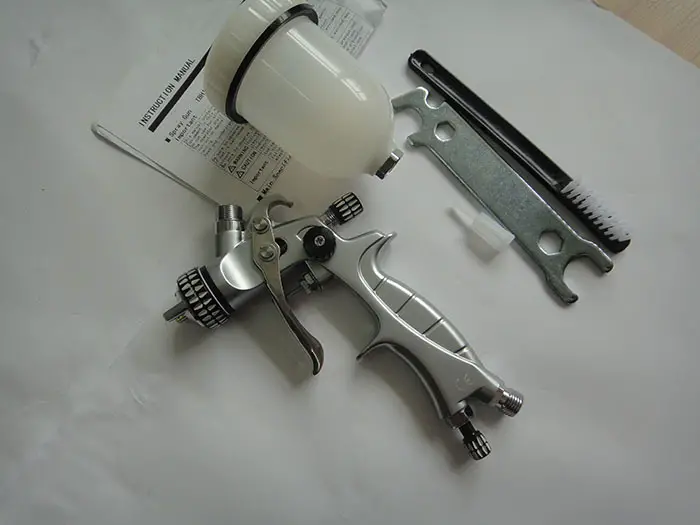
photo source: aliespress.com
As there is more to say about spraying, I will come back to the subject soon. In the meantime I await your questions on the subject.




























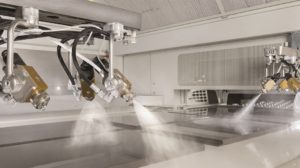




Hello dear Mrs. .
I have a question for you. I have a holiday home and it is made of wood. This year I would like to paint it and I would like to paint it with SAVANA TECH (wood varnish). I bought a compressor that puts out 8 bar. My question is if I can use this compressor for what I want to do and what kind of gun do you advise me to buy.
Thank you in advance.
Hello,
In general, SAVANA varnishes are products made to be used by anyone who wants to polish. The product is not very viscous so you can use a regular 1,8-2 mm nozzle gun. Being a solvent based product it is not necessary to have a stainless steel gun, but I advise you to buy a stainless steel one anyway. You never know when you will need it again. Don't buy the most expensive one - it's a useless investment if you don't want to use it permanently, but don't buy the cheapest one either. Usually very cheap products are a headache even if you only use them once. You can use the compressor you bought. You will adjust the jet pressure and the amount applied from the gun. It's simple, you can find this in the instructions. Good luck!
Thank you very much and I remain a fan of yours.
Have a wonderful evening.
Could you give me, if you please, a brand or a certain type of gun, possibly a picture to orient myself, I do not want to advertise.
Be careful...if the holiday home has already been protected with varnish, bath...it is very important to remove the old layer very well...it is actually more difficult to prepare the surface than to apply the new protection.but if it is applied without preparing the surface...it is wasted work and money spent...the results will not be as expected...it must be well cleaned/sanded before applying, even if it has only dust.
About the compressor...8 bar pressure is not important...most compressors provide 8 bar...what is important is the flow it provides (I guess it has a tank/buffer vessel).it must have a flow of at least 1 cubic meter per minute.
Hello,
Kindly, if you can, clarify a dilemma. Can the spray gun be used for a water-based, colorless, Savannah wood varnish? I ask because on the box, under how to apply, it doesn't say to apply with the spray gun, only brush and roller. I have found some opinions on the internet that "it is not recommended to apply water-based varnish with a spray gun because this type of product generally has a tendency to foam, and spraying intensifies this characteristic". What do you as a specialist think about this?
It would save me extra effort and time to spray the lacquer with a spray gun, especially since I have to lacquer for myself personally, a cabinet with laminated doors and it is quite inconvenient and time-consuming to apply with a brush on such a surface.
I intend to purchase a very good quality all-purpose spray gun, but one that I will use in the future occasionally, at home, on any type of paint, without having to dilute it, unless the manufacturer already requires it.
I could use your recommendation for such a gun . Never mind the budget.
With all due respect thank you in advance 🙂
Hello,
Indeed, water soluble products foam more. The air with which they are mixed during spraying encourages this. But it should not be considered impossible to apply with a spray gun. You have to give it more time so that the air can escape, you don't force it to dry and the layer applied is not thick. Preferably 2-3 thin coats instead of one thick one. Lacquers that are formulated for brush or trafalette do not have added defoamers like spray lacquers. But again, with a little more care it can be applied with a spray gun. Try to dilute as little as possible or not at all. Added water increases foaming and lifts the wood grain even more.
As for the gun, I will send you the answer by email. 🙂
All the best!
Hello dear lady,
Thank you very much for your answer. I have no experience but I will try to follow your advice regarding the application. I have already purchased a spray gun that claims the lacquer does not need to be thinned, so hopefully the foaming would not have any reason to increase and can spray including the wash without the need to thin. I don't mention the gun so as not to advertise, although I would have been curious to get an opinion from a specialist like yourself. In any case, it wouldn't be bad if you could email me what gun you would have recommended, so that I could see if I had rushed into buying this one. I haven't used it at all yet, so I might as well return it, if necessary...
All the best! 🙂
Hello,
I sent you the email on Monday (5 December). Look in spam too, it might be there, it's happened to me before. By email you can also tell me which gun you bought. If I have data about it, I will be happy to tell you. From what you tell me, the pistol you bought is with a large nozzle. That explains why you can apply undiluted varnish and washable paint. The only problem you may have is if you have to spray more fluid materials (baths, thinner varnishes). But it can be solved if the gun has more nozzles, or if you buy another nozzle that fits the gun, size 1.5-1.8.
All the best.
Hello, I also need some advice to paint a wooden fence about 150 ml . It was painted some time ago (4 years) with an alkyd metal and wood paint. Now it has peeled in places and looks ugly, mentioning that this is how I bought the land. The question is what could I paint or varnish the fence with and what type of gun? As it is too large an area for the brush. The color is also very dark . Thank you very kindly
Hello,
If it is not completely cleaned you should still use an alkyd paint. Other solvent-based paints are incompatible, and water-based paints, the ones usually used, may not adhere. If it were a new or totally cleaned fence I would recommend a waxed coloured impregnator. There are water based products that get into the wood well and stain it deeply. On the surface they do not form a visible film but the wax in the product protects well against moisture. Over time, even if some of the surface material is washed away, the colour that has entered the wood and is UV resistant remains and is not visible as when the coloured film is removed.
Application can be done with a regular 1.8-2 nozzle gun. They are available in DIY stores. Don't buy the cheapest one (so you don't have problems with the gaskets), but don't buy the most expensive one either (for a DIY job once in a while it's too much). You'll also need a compressor as an air source. You don't need a big one. The important thing is to have 4-5 atmospheres. If it is more handy you can also choose an electric gun.
Hello!
With a question, can I apply Lazur Sadolin with a spray gun?.... in the leaflet it says that it is applied only brushable.
Thank you!
Unfortunately, I can't help you here. You need to speak to the manufacturer's representative. Each company has their own formulas for their products and they cannot know if the product is suitable for spraying. If the directions for use say to apply it only by brushing, this is probably the only way to achieve the desired quality. Try to find a Sadolin representative and ask for further information. There are generally such representatives in DIY stores.
All the best!
Hello.
I made a small (coffee) table from solid oak. I'm at the stage on sanding the table, but I wanted to ask you and ask your advice. I want to apply a polyurethane varnish for wood (two-component) LPU from isocor. can this varnish be applied with a paint gun?
Hello.
The varnish you are talking about is for concrete surfaces and the manufacturer recommends applying it with a brush or trowel. To apply it with a spray gun you should dilute it more than 5%. The manufacturer says that at a higher dilution the properties of the product are not the same. Being a wooden table you should use a polyurethane wood varnish. These you can apply with a spray gun.
All the best!
Don't forget to subscribe to the printed Wood Magazine! For only 58 lei/year you can find out news in the field, discover craft ideas or trade secrets. We remind you that the content in the printed magazine is different from the one on the website. Details in the link below.
Thank you!
https://revistadinlemn.ro/product/abonament-revista-din-lemn/
Good evening,
I also have a question for you, please. Can I apply nitro lacquer over solvent based bait? I intend to spray lacquer. What diameter should the gun nozzle be for this type of lacquer? Thanks!
Hello!
Over regular baths (dye and thinner), no problem. Over those containing wax or oils, not because the varnish will not adhere. Let the surface dry (let the solvent evaporate) before applying the varnish.
For varnish, the recommended nozzle is 1.8-2 mm and for simple baths (dye and solvent), 1.2-1.5 mm.
All the best!
Good evening,
Thank you very much for your answer. Please come back with another question. Can I spray two-component polyurethane varnish over solvent-based bath? If so, can I use a gun with a nozzle diameter of 2 mm?
Good riddance!
Good evening!
Yes, you can apply polyurethane varnish over solvent-based bath. Likewise, the dip must be a mixture of dye and solvent, with no added resins, wax or oil. If the grout has added resin it must be specified that the resin is compatible with the polyurethane lacquer. And yes, you can use the 2 mm nozzle gun.
Caution: with chemically drying (hardening) varnishes, such as polyurethane varnish, you must wash the gun with thinner as soon as you finish the work. Otherwise, the lacquer hardens inside the gun and the product formed is no longer soluble in the thinner. It will be very difficult to recover the gun and you will most likely have to replace it. If you use the pump for application, wash the hoses as well.
All the best!
Hello!
I would really appreciate it if you could help me with some information.
I have a log cabin and would like to varnish it inside and out.
Being a larger surface (30sqm) I would find it difficult to brush, that's why I would like to buy a spray gun, but I don't know what would be better. What size nozzle and lacquer would be best?
The cottage, of construction , has a layer of varnish on the wood. Can I now apply varnish directly on it, over that layer of varnish?
Thank you very much!!
Hello!
You need a pistol with a 1.8 or 2 nozzle. The varnish you can apply depends on what the original wood was coated with. If you bought it from a local manufacturer, ask what they used. Those bought from the big DIY stores generally have a water-based primer. In this case apply a water-based exterior varnish. Also apply a water-based varnish if organic solvent-based varnish was used initially. You can also use it indoors. Exterior water-based varnishes have a higher viscosity, so you need a spray gun with a larger nozzle. A regular varnish can also be applied with a 1.5 mm nozzle.
If oil or alkyd varnish has been applied, you must also use an alkyd varnish because water-based varnishes have no adhesion.
All the best!
Thanks for the excellent documented articles. I have gotten into the habit of looking here for the necessary information
I have just now taken the liberty of buying a compressor and I thought I could apply my own paint.
I would like to ask you a question: is the quality of HVLP, LVLP or "classic" determined by the nozzle used?
Hello!
Thanks for your appreciation!
More specifically, it would be the air cap gun. It's not just the outlet but the whole assembly. They are different technologies that allow the application of a smaller or larger amount of material, with different viscosities, different material losses and different air supply. In general, guns are different for each type of application. But I have also seen demos where the same gun is used and only the air head is changed. All of them are, of course, the same brand.
All the best!
A very important article about how much attention should be paid to such a device.
Thank you!
Good evening, I make small wooden objects which I then paint and varnish with paint or spray varnish. In order to save money I tried to paint and varnish with a spray gun and paint bought in a box. The problem is that the air pressure from the paint gun blows my parts off the work table. I've also tried the airbrush, but it has a small surface area. I've seen that there are mini paint guns on the market. Do you think such a mini gun would be useful for me? If so, what nozzle should it have for painting and varnishing? Thanks in advance!
Hello!
Regular spray guns rely on air pressure to turn the liquid into tiny droplets that evenly paint the wood. It's hard to find guns that paint well and have such low pressure that they don't move the pieces. Guns that use lower air pressure are HVLP which are modified so that the material can be sprayed at a pressure of up to 0.7 bar, as opposed to 2.5-3 bar like conventional (regular) guns. The material applied must have low viscosity and so a large amount of thinner is used. Productivity is low, but the film obtained is uniform and of good quality. More information about these spraying systems can be found in the links below.
In the case of painting very small parts, the immersion method or painting in mills is used. For dipping you need to have a device with many fixing places (a metal frame with many welded nails) which you put into a bath of dye/lacquer/paint. You can paint several parts at once this way, but it has the advantage of the catch mark and if the material is not well chosen, of drips.
In the colouring mills the materials are placed in a rotating drum and the varnish or paint is dripped over them through a pipe above. After a while, air is introduced into the rotating drum so that the pieces come out dry. The staining and varnishing/painting is uniform and no marks remain, but the machine is more complicated.
All the best!
https://revistadinlemn.ro/2018/05/30/pistoale-de-pulverizare-care-reduc-pierderile-de-lacuri-si-vopsele/
https://revistadinlemn.ro/2017/12/12/cum-sa-alegi-pistolul-de-pulverizare-avantajele-si-dezavantajele-celor-mai-folosite-sisteme/
Hello,
I would like to use a paint gun to oil a wooden shed I want to keep in my yard. I'm not sure if it would work since the oil is a little vaster. My question is if you can use a spray gun for something like this (with a bigger nozzle possibly, I'm not sure).
Thank you very much.
Hello!
You can apply the oil with a spray gun, just thin it if it is very viscous. Oil thinners are white spirit (gas, petrosin) or other petroleum solvents or turpentine. Use a gun with a 1.8-2 nozzle. It will apply better than with a brush and will get into the wood better because it is more thinned. Getting in deeper will protect better and longer.
Good luck!
Bye!
I recently purchased a paint gun, Walcom with a 1.9 HTE nozzle (on the recommendation of a specialist), what I do not know and want to know is: can I paint with water-based varnishes and can dilution be done in such a way that it does not destroy the chemical bond between the components of the product? For the spray gun I use a compressor that absorbs around 300 l per minute and refluxes 230, it works up to 10 admospheres.A recommendation for a good varnish to use outside if possible.Thanks in advance!
Good evening!
It can also be used to paint with water-based products. For these products the dilution should not exceed 10%. Do not use a pressure higher than 3.5-4 atmospheres. Too high pressure will lead to high varnish losses. Use a pressure regulator on the line from the compressor to the gun or adjust with the regulator on the gun (if available). For good results use materials from manufacturers specialising in wood varnishes and paints (ICA, Sirca, Sayerlack, Milesi, Renner, etc.) Their sales representatives can help you with further information on application.
Good luck!